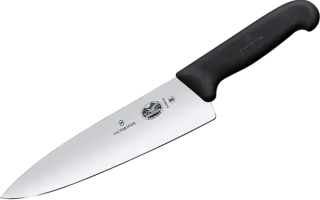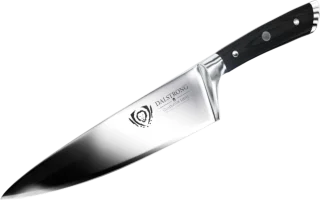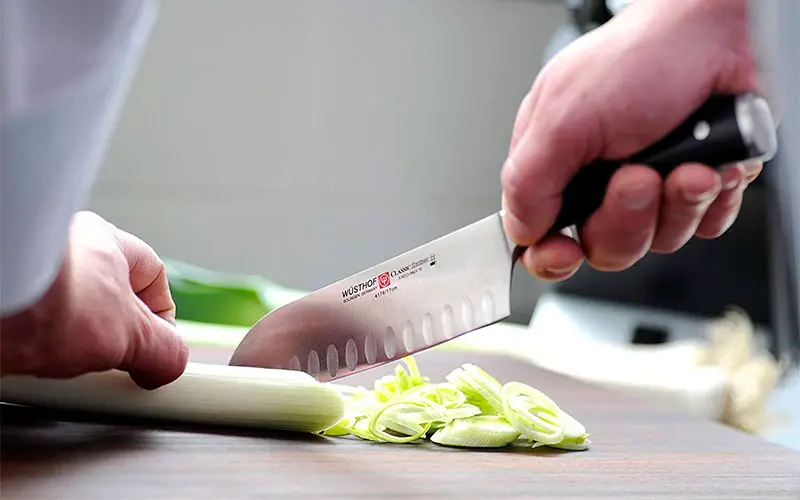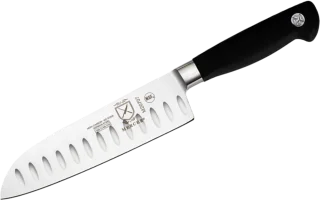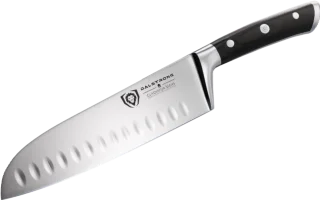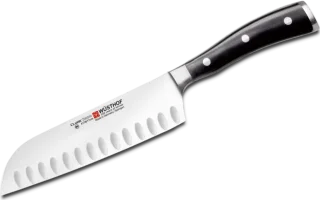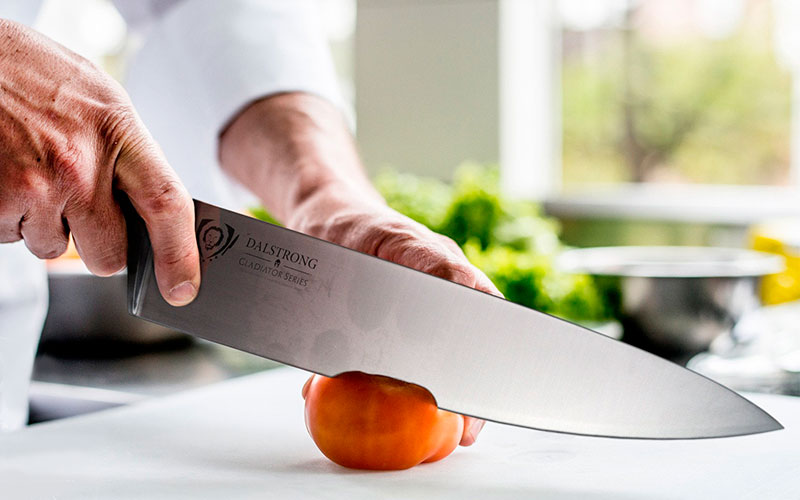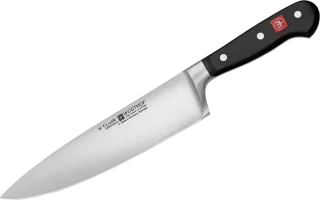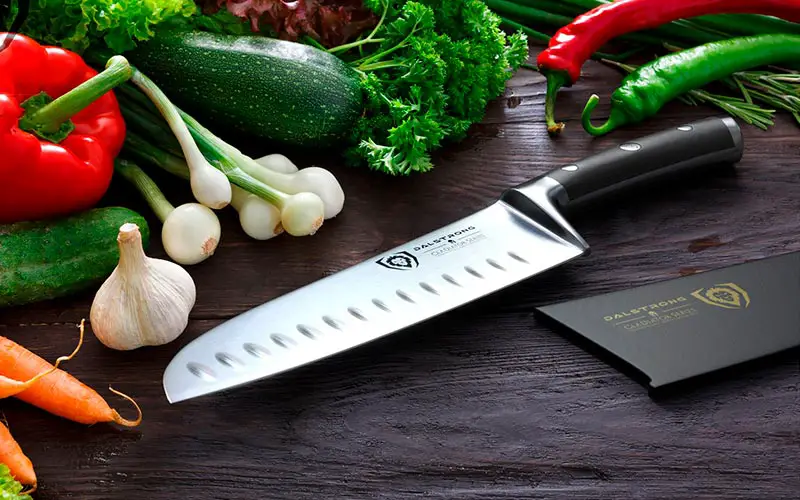
Whether you are a kitchen enthusiast or a professional cook, you will agree with me that a knife is an indispensable cutlery in the Kitchen. Activities such as cutting, mincing, shredding, and dicing of meats, tubers, spices, and veggies are done with Kitchen knives.
k
However, there are many types and different grades of Knives out there. Some have qualities that are suited for different kinds of cooks and based on their preferences. While some knives can be used by professionals, some are suited mainly for home use.
This article portrays two basic types of kitchen knives, their comparison, and what they are best suited for. They are the santoku and chef knives. Want to know more? Let’s take a drive together to Santoku VS Chef knife review!
Basic Description of a Santoku Knife
From the Merriam Webster dictionary, Santoku was defined as a multipurpose kitchen Knife of Japanese origin with a lightweight blade or slightly curved cutting edge and a spine that curve downwards to the tip. The name Santoku means three virtues and applies to the knife due to its ability to mince, chop, and dice food items.
Perhaps one prominent feature of this kitchen knife is the presence of hollow-like cavities engraved on the blade surface. These hollow-like cavities can also be referred to as scalloped Granton edges. These gratins allow for the generation of air pockets, which enables cooks to slice food items thinly and conveniently.
The gratons also prevents food cuts from sticking to the surface of the blade. The santoku knife is best suited for people with little hands due to its lightweight feature and well-balanced grip.
Santoku knives can be found with blade lengths around 5-7.9 inches in size and mainly known by cooks to create the best slices through a chopping motion. They often come with handles that have a non-slip feature and a full tang.
What is a Santoku Knife Best Used For?
When compared to the western style of Chef knife, one will observe the santoku knife to be smaller and have a lightweight. Santoku knives over the years are known to be adept at creating thin slices of food. They are best used for:
- Cutting meats (not meat bones)
- Slicing cheese
- Mincing meats, vegetables
- Creating tiny slices or chops of vegetables and meats
- Scooping off food on a cutting board
What Size of Santoku Knife is The Best?
The best sizes of the santoku knives are those with a blade length around 7 inches as they can perform more cutting tasks efficiently. With a 7-inch blade length of santoku, the tread of chopping, mincing, and dicing comes easy. It is also a standard size for either people irrespective of hand size or whether a newbie or expert use it.
Description of Chef Knife
A Chef Knife comes with a general-purpose more than just the blade itself. Forged from a single piece of steel a chef knife comes with excellent abilities of mincing, slicing, dicing, cutting, disjointing, and munching food items. It is a western type knife with types in German and French style. In short, this is a western version of the Santoku and can often be mistaken for one another.
It comes with a blade length that ranges from 8-12 inches in size. Most of its type comes with a thick and strong build which allows it to be used on a large scale to make thicker cuts of meats (not bones) and vegetables.
The German-style of this Chef Knife has a more curved section at the blade front good for cutting in a rocking motion while the French style is a straight triangular type for a slicing type of motion.
What is a Chef Knife Best Used For?
Working in the kitchen requires you to make use of the best precision forged knife to make cooking tasks comfortable. The chef knife is a multi-purpose knife used for a variety of Kitchen tasks.
It comes with a thickened blade steel useful for cutting heavy-duty food products like potatoes, thickened meat, and thick vegetables. In general, it is ideal for cutting meats, slicing herbs, chopping nuts, and dicing vegetables.
What Size of Chef Knife is The Best?
The standard sizes of Chef Knives vary mostly from 8- 12-inch size. But while a professional chef can make use of a 12-inch chef knife effortlessly, it might be difficult to use by a newbie. However, despite this indifference, there is always a size suitable for everyone. A standard chef knife around 8- inch is the best as it is medium-sized can be used by either experts or amateurs and will still achieve the same desired effect.
Do Santoku and Chef Knife have anything in common?
Amidst all differing features, the santoku and Chef Knife are both high precision forged to give the sharpest of all quality needed in a knife. They are both futuristically made of steel blades that enable effortless slicing, dicing, chopping, and mincing.
Differences Between a Santoku and Chef Knife
For some newbies, it often easy to mistake a santoku knife from a chef knife because they are similar in function. At a glance, the santoku is sometimes said to be the Japanese version of Western-type Chef Knife. However, there are some specified differences in their physical features and functionality. These differences fall into the category of size, type of blade, uses, and weight.
The Blade Features – Santoku Knife vs Chef Knife
One prominent feature that differentiates the santoku from the western chef knife is the blade. Now, when you look at the Santoku Knife, you find hollow like indentation at the edge of the steel blade. This feature enables the knife to form air pockets that help prevent food from sticking to the surface.
Meanwhile, Chef knives have a totally plane surface and can achieve fast cutting due to their broad tapered shape along with a delicate, sharp edge.
Size – Chef Knife vs Santoku
On looking through both the available santoku and chef knife. It is observed that the santoku knife comes at a size smaller than the chef knife. The santoku knife has a standard size between 5 -7 inches (mostly 7 inches). A typical Chef knife comes at a standard size between 8-10 inches.
Mode of Cutting – Santoku vs Chef Knife
The way a santoku knife is used in cutting food is quite challenging from the way you use a Chef knife. The chef knife usually comes in a curved section and the blade front idea for cutting in a rocking motion.
Meanwhile, the flat blade of the santoku knife is available for cutting in a chop-like motion.
Weight – Chef Knife vs Santoku Knife
In terms of weight, the santoku knife is lighter than a typical Chef knife. It also comes with a delicate balance that makes it useless fatiguing. A Chef knife comes with a thickened and moderately dense weight. This is the reason why the santoku knife can’t be used on a heavy-duty scale.
However, the santoku knife is best suited for use by individuals with small hands. Except if you are a professional chef use of the chef knife will be quite strenuous.
Best Santoku Knives – Santoku vs Chef Knife
Mercer Culinary Genesis Forged Santoku Knife Best Cheap Santoku Knife
Mercer Culinary Knife is what defines modern craftsmanship for high quality and professional cutlery. It comes with unique abilities suited for use in kitchens in slicing, mincing and chopping meats and veggies. From a closer look, I observed that the Genesis santoku knife is one with a blade length of 7-inches and is lightweight, making it easy to handle by chefs with small and delicate hands.
However, this lightweight design makes it unsuited for the broad-scale purpose. The Knife has a Rockwell hardness of 58 and a sharpening angle about 20-degrees. It comes with a well-structured and durable handle made of Santoprene (a mixture of rubber and plastic compounds).
Materials and Features
The handle is so structured that it provides the needed insulation against kitchen heat. It features a full tang that runs through its base length.
The presence of a non-slip feature on the handle allows you to grip the knife efficiently (even when wet) hence ensuring its safety for use in kitchens. Asides from the handle, it also comes with a carbonized steel blade that is resistant to corrosion and discoloration from extreme usage. Hence, requiring less maintenance culture with its use.
As seen on the knife are hollow like indentations that allow for fast cutting and release of foods. In between the handle and carbonized stainless steel is a spine (also known as a bolster) that runs through half of the blade’s base length. Bolster acts as a joint between the stainless steel and the Santoprene handle, which in turn provides strength and balance when handling.
How to Take Care
The use of the Mercer Culinary Genesis Forged Santoku knife requires that you don’t clean in the dishwasher as harmful detergent and chemicals can impair its quality. Clean and wash by hand with soap and water and dry with a towel. Storing requires the use of Knife blocks to keep the knife dry.
- Made from corrosion resisting carbonized German steel
- Non-Slip Santoprene handle protects from heat
- Works with minimal friction with the presence of hollow like cavities
- Extremely sharp
- It is NSF certified, meaning its safe for use
- It requires regular oiling
DALSTRONG Santoku Knife Gladiator Series Best Affordable Santoku Knife
The Dalstrong brand has been known for quite some time for making premium kitchen cutleries, and such an impression can be found on the Dalstrong Santoku Knife. The Dalstrong Santoku Knife is what I regard as a top-notch knife with an exceptional design fit for use by professional chefs.
All out of the box, this 7-inch sized knife comes along with a User Guide and Dalstrong sheath for enclosure when idle. It features a highly carbonized Thyssen Krupp German steel that is indeed durable, ultra-sharp, and resistant to wear.
Tha edge
The steel blade has also been hand polished by the edges to a 14-16 per side angle to improve its resilience and cutting technology. The premium quality of the razor steel blades highlights the presence of chromium on the steel blade to resist stain and makes it easy to clean.
Handle
A closer look at the handle shows it is made out of premium quality pakkawood handles with a build perfectly fit for use in busy kitchens.
The handle features a full tang running through its entire length and contributes to the Knife’s sturdiness. The handle is carefully engineered for a perfect grip when in use while also providing the needed maximum comfort.
The handles are triple fastened with the use of rivet to enhance more durability. It features two bolsters of which one is at the spine and the other as an end cap. The spine bolster balances the pakkawood handle with the polished stainless steel and protects one’s fingers.
How to Take Care
Cleaning this santoku comes easy as all you need is soap, water, and detergent. Making use of the Dalstrong Santoku knife requires that you make use of the protective sheath or store it in a knife block so as not to impair the blade’s sharpness.
- Quality, wear-resistant blades
- Well-polished with a premium look
- Comes with a locking sheath for protection
- Full tang and triple riveted knife
- Needs regular sharpening after use for a long while
Wusthof WU4176 Classic Ikon Santoku Knife – Best Premium Santoku Knife
The Wusthof Classic Ikon santoku nice is a Japanese style 7-inch knife with a triple function of mincing, dicing and slicing. It comes out of the box has a durable and lightweight knife with impressive premium features found suitable for use by an adept chef in making Asian and western style foods.
Handle
This Knife is said to be comfortable to use as it features a primitive-looking handle made of Polyoxymethylene from black wood. It comes with an ergonomic handle somehow curvy providing a soft grip top handle and guarantees a level of safety. The knife-like many others come with a full tang that runs through its entire length.
The full tang on the handle provides the needed robustness and contributes to its durability. The handle features three rivets joining the handle at both sides to improve the Knife’s durability.
Blade
Furthermore, the knife comes with a premium-looking alloyed steel blade, giving it the required quality of resistance to stains, wear, and confers on it an easy-to-clean feature.
It is shaped in such a way as to have a pointed top tip on its downside. Embedded on the knife are hollow-like grafts that reduce friction and prevent your food from sticking on the Knife’s surface.
Also, the classic Ikon Santoku knife features two bolsters. The bolster between the blade steel and handle helps in protecting fingers from sharp ridges. Another bolster that exists at the handle cap is meant for counterbalancing.
- It is quite comfortable because of its lightweight nature
- Presence of a rear bolster on the handle to balance the knife’s weight
- Comes with a full tang
- Presence of an effective non-slip feature
- Requires regular honing and sharpening
Best Chef Knives – Santoku vs Chef Knife
Victorinox Fibrox Pro Chef’s Knife Best Chef Knife for Begginers
The Victorinox Fibrox Pro Chef’s knife is sure to be one of the best companions of a culinary artist in the kitchen. It is an inexpensive, excellent, and reliable chef knife for great home cooks. It is known to come with a duly esteemed framework for slicing and cutting the softest meat to the roughest into small perfect pieces.
Crafted in Switzerland the Victorinox Fibrox Pro Chef’s Knife can be used on a large scale thanks to the fact it has a 7.9-inch size. It comes with a soft ergonomic handle made out of Thermoplastic elastomer that provides a robust and non-slippery grip even when wet.
A thermoplastic elastomeric handle like this renders the knife safe with the use of a dishwasher to clean. The handle material ensures safety while it is being used.
Blade
Now speaking of the blade, the Fibrox Pro chef blade is constructed out of a stainless European steel material making it durable, stain-resistant, and corrosion resistant. The blade steel was built to be extra wide, making it great for use by beginners who need proper stability when cutting and slicing.
For its design, the blade steel comes with a normal straight edge for effective and proper slicing. It features no hollow ridges meaning the sliced foods will occasionally stick to the blade’s surface.
How to Take Care
Maintaining this knife involves that one should properly clean with soap and water. Although the Victorinox website recommends that it can be washed using a dishwasher, I did strongly disapprove and advise you to stick to the old method of hand washing to keep your Knife stain-free.
Storing will involve keeping in a knife drawer or thrusting into a Knife block so as not to impair its sharp quality.
- Made from a corrosion free blade steel
- Extra wide blade rendering useful for beginners who need to master stability
- Ergonomic Fibrox Pro handle
- No Bolster
Dalstrong Chef Knife Gladiator Series Best Value for Money Chef Knife
The Dalstrong Chef Knife is what I call a superior high-end knife with a top-notch design fit for use by professional chefs. It features a highly carbonized Thyssen Krupp German steel that is indeed durable, ultra-sharp and resistant to wear.
PakkaWood
Looking at the handle, one will observe it is made out of premium quality pakkawood handles with a build perfectly fit for use in busy kitchens. The handle features a full tang running through its entire length and contributes to the Knife’s sturdiness.
The handle is carefully engineered for a perfect grip when in use while also providing the needed maximum comfort during use. The handles are joined together with three rivets to enhance durability.
Blade
The steel blade has also been hand-polished by the edges to a 14-16 per side angle to improve its resilience and sharp cutting technology.
It features two bolsters of which one is at the spine and the other as an end cap. The spine bolster balances the pakkawood handle with the polished stainless steel and protects one’s fingers. Meanwhile, the second bolster is meant for control balancing and helps give the Knife a clear distinction from many other inexpensive ones.
How to Take Care
Cleaning the chef knife comes easy as all you need is soap, water, and detergent. Making use of the Dalstrong Chef knife requires that you make use of the protective sheath or store it in a knife block to prevent it from dulling.
- It has easy to maintain and sharp-edged blade
- It has excellent weight balance
- Comes with a unique finish with a stylish look
- The blade is made from German steel that renders the knife rust resistance
- It is easy to clean
- It comes with a heavyweight
WÜSTHOF Classic 8 Inch Chef’s Knife Best Premium Chef Knife
This is one of the best all-purpose chef knives that is made in Germany. It was designed with features suited for use by newbies, cooking enthusiasts and tends to be a truly loyal companion in the kitchen.
Blade
It comes with an 8-inch size blade, which is medium-size to perform small and large-scale tasks. Speaking of the blade, it is constructed with a Precision edge technology out of a highly carbonized European steel alloy that ensures a 0.2 sharper blade and 0.2 x edge retention.
The steel alloy blade guarantees that this chef knife can resist corrosion and stains. Hand polished to a 14 degrees sharp edge this chef knife is exceptionally thick, sharp and can cut through heavy food items like potatoes, veggies, full chicken, and beef steaks.
Handle
The WÜSTHOF Classic Chef’s Knife features a knife handle with a full tang running through the entire length of the handle. The handle is made of a polyoxymethylene handle which allows a firm non-slip grip even when wet. For exceptional durability, the handle featured a full tang running through the entire length and joined with three rivets.
The handle makes it easy to handle the chef knife as it comes with a well-contoured design. The triple-riveted handle, in turn, makes the knife duly safe and hygienic for use.
The presence of a full bolster around the spine, joining the handle and blade steel ensures it is comfortable and safe to use.
- Comes with a bolster that adds extra balance
- Has a well-sharpened edge
- Proven quality for years
- Quite heavy to use
Santoku vs Chef Knife – Final Word
Whether you are a professional chef or a kitchen enthusiast, your cooking needs require you to make use of the best variety of knives. This post contains a comparison of the best pairs of knives along with their reviews and potential benefits.
Do remember when making use of these special knives you need to keep a proper maintenance culture so you won’t impair its quality.
Therefore, for whichever knife you are getting keep yourself aware of its usefulness and then you can make a well-informed decision.
Did you like this Santoku vs Chef knife review? Please share in comments and don’t forget to check my review on Nakiri vs Santoku knives.
